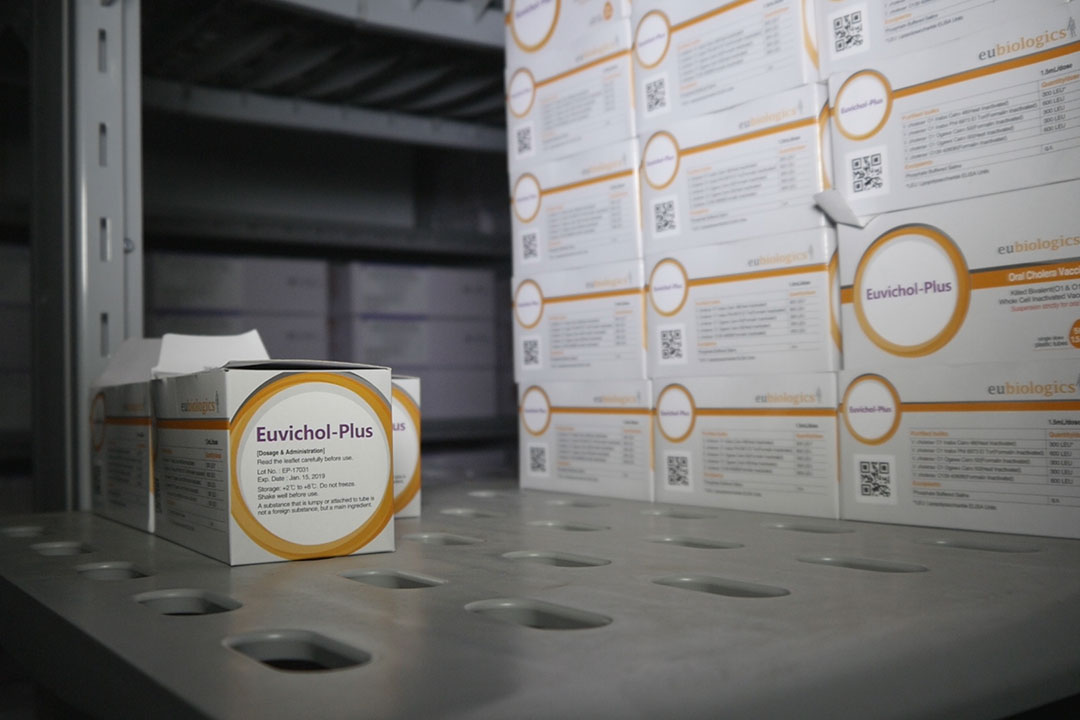Interview: how we’re working to boost global cholera vaccine supply
EuBiologics is the sole supplier of cholera vaccine for outbreaks, at a time of unprecedented demand. Its director of international business, Rachel Park, explains how they plan to increase global supply.
- 11 September 2024
- 6 min read
- by Linda Geddes

Demand for oral cholera vaccines has never been higher, but this is a relatively recent phenomenon. What has triggered it?
Climate change, poverty, conflict, increased availability of oral cholera vaccines, as well as work by international stakeholders to raise awareness of them, have all contributed to increased demand for cholera vaccines.
Three vaccines have received WHO prequalification. The first, in 2001, was Dukoral, but it is relatively expensive and needs to be administered with a buffer solution, which is not convenient for outbreak settings, and that limited global demand for it.
The next vaccine was Shanchol, manufactured by Shantha Biotechnics. It was more affordable, and appropriate for use in reactive campaigns, but manufacturing capacity was limited to only 2 to 3 million doses per year, which meant that many countries didn’t have the opportunity to use it. This also limited demand.
EuBiologics entered the market through a partnership with the International Vaccine Institute (IVI), and our vaccine, Euvichol, was prequalified in December 2015 with an initial annual capacity of 6 million doses, although it has increased significantly since. It took time for global stakeholders, including the Gates Foundation, Gavi and UNICEF, to do the advocacy work to raise awareness of oral cholera vaccines and their efficacy. This work, coupled with extreme climate-related disasters such as flooding and cyclones, has been the main driver for increased demand.
Poverty and conflict are further drivers. Cholera is associated with poor sanitation and can affect refugee and migrant populations when there’s overcrowding and insufficient access to water. Urbanisation also can lead to the growth of slum areas that do not have adequate sanitation, contributing to outbreaks.
We expect our overall capability to produce oral cholera vaccine to increase to more than 50 million doses in 2024, to more than 70 million doses in 2025, and to more than 90 million doses by 2026.
Over the years, you’ve made various changes to your oral cholera vaccine; how have these helped to boost supply and delivery?
We have made efforts to increase our annual capacity, alongside formulation improvements to the vaccine. One improvement was removing thimerosal, a preservative, from the formulation: it is better not to have preservative in the vaccine, and we don't think it is needed, because Euvichol is a single-dose vaccine.
Another improvement was changing the presentation of the vaccine from glass vials to plastic tubes. This has several advantages: it facilitates delivery by reducing the volume by 30%, and the weight by 50%, compared to glass vials. It is also more convenient from an administration perspective: field workers told us that opening the caps of the vials was challenging; they sometimes needed tweezers to do it or hurt their fingers opening the caps, and it was hard to see how much volume was left in the vials. With a plastic tube you just twist the cap and split it.
Alongside these changes, we increased production capacity by investing in a 600-litre fermenter, and have made continuous changes to improve yield, gradually increasing our capacity to 33 million doses, prior to the prequalification of our latest formulation of oral cholera vaccine, Euvichol-S.
In April 2024, WHO granted prequalification to Euvichol-S. How does it differ from previous versions?
Euvichol is an inactivated whole-cell vaccine, meaning it contains killed Vibrio cholerae bacteria. Our previous formulation, Euvichol-Plus, contains five heat- and formalin-inactivated strains: two of the Inawa serotype; two of the Ogawa serotype, plus the 0139 strain. However, 0139 hasn’t been seen for a hundred years, so there’s no point including it. Also, we thought that just one Inawa and one Ogawa strain might be sufficient.
Euvichol-S is a simplified vaccine containing just these two components, inactivated using formalin alone. A Phase 3 clinical trial of Euvichol-S conducted in Nepal demonstrated that it was non-inferior to Shanchol in terms of immunogenicity and safety.
Simply by switching our production from Euvichol-Plus to Euvichol-S, we can increase our production capacity by 40%. We are also working on scaling up the expansion of our manufacturing facility with support from the Gates Foundation. Coupled with the increase in production capacity, we expect our overall capability to produce oral cholera vaccine to increase to more than 50 million doses in 2024, to more than 70 million doses in 2025, and to more than 90 million doses by 2026. We hope this will help alleviate supply constraints of oral cholera vaccines worldwide.
Bringing a new vaccine to market isn’t easy, and you’ve also had the COVID-19 pandemic to contend with. How has this affected your business?
Due to preventative measures brought in to limit the spread of COVID-19, there was no demand for oral cholera vaccine at the peak of the pandemic. Although we have other vaccines in the pipeline, Euvichol is our only product, and at that time we were expanding our production capacity, so it created a really challenging situation. Fortunately, Gavi and UNICEF offered to make prepayments for our cholera vaccine, which enabled us to continue our expansion work and remain sustainable, despite COVID-19.
EuBiologics is currently the sole supplier of cholera vaccine for outbreaks, following the withdrawal of Shantha Biotechnics from the market in 2002. Is this a blessing or a curse?
Ideally, a healthy vaccine market needs more than one supplier. If a country asks how many doses of oral cholera vaccine there are in the WHO’s global stockpile, and they are told that there’s a limited number of doses, they may adjust the number they request because they know that even if they request them, they are not going to get enough vaccine.
Also, there are some countries with requests for preventive cholera vaccination campaigns that have been approved, who are waiting for vaccine to be delivered, because the supply of vaccines is not sufficient. If an additional manufacturer increases supply, it means the market can grow, and we can compete with them in a healthy way.
What else can the global health community do to help to support manufacturers like EuBiologics to maximise vaccine production?
During the early years, demand for oral cholera vaccine did not materialise as expected, so we had a difficult time planning its production.
Then, in 2022, the International Coordinating Group [which manages emergency stockpiles of vaccines] decided to suspend the usual two-dose strategy for oral cholera vaccine, because of supply constraints, and use only a single dose in outbreak settings, following a recommendation by the WHO’s Strategic Advisory Group of Experts (SAGE). Because these outbreak requests are so frequent and large, there have been no preventive campaigns since then.
If we have a preventive campaign, we know roughly how many vaccines will be needed and when. But if we only have demand from reactive campaigns to address outbreaks, that demand is not predictable, so it’s unstable.
We are producing vaccines at full capacity at the request of global stakeholders, who assure us that the vaccines we produce will be shipped at some point. But we are a company and need a stable cash flow for sustainability, so it can be a concern. We are eagerly waiting for global stakeholders to restart preventive campaigns.









